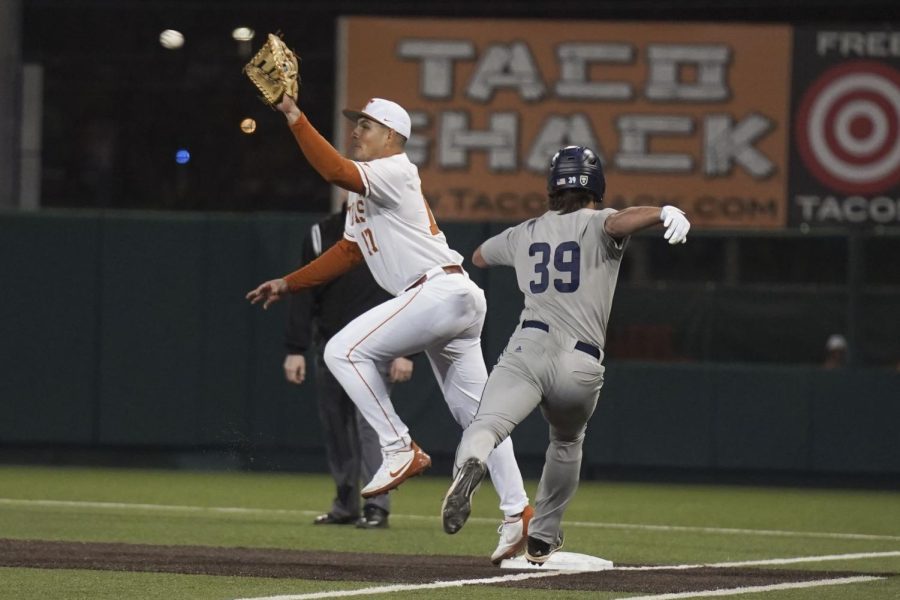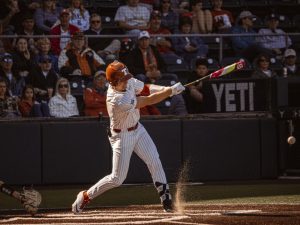Longhorns rule Big 12 in OPS, so what’s behind Texas baseball’s recent slump?
Texas baseball first basemen Ivan Melendez uses his glove to help secure the out at first base. Texas played Rice at UFCU Disch-Falk Field on Feb 18, 2022.
March 31, 2022
After dropping an intense midweek rivalry game to unranked Texas A&M on Tuesday, No. 8 Texas baseball continues its slump, going 8-8 in its last 16 games. The Longhorns feature some of the most dynamic bats in the country, averaging 8.5 runs per game during the 16-game stretch, but wins against solid opponents have been hard to come by.
In a statistically driven sport, here’s what the analytics have to say about Texas and what it could mean going forward.
OPS
If there’s a single number to judge a hitter by, OPS (on-base plus slugging percentage) is arguably the best stat to use. It isn’t perfect — it notably ignores stolen bases — but it gives a general idea of which batters are having the most success behind the plate.
So far this season, Texas has three players with an OPS over 1.000: redshirt junior Ivan Melendez, redshirt senior Murphy Stehly and redshirt sophomore Trey Faltine. Melendez, who is tied for the most home runs in the country with 13, and Stehly, who has the second highest batting average in the country, make a mockery of the stat. Both have an OPS over 1.300 and have the two highest OPS scores in the Big 12. Faltine sports the fifth best OPS in the conference.
Redshirt senior Skyler Messinger and redshirt sophomores Douglas Hodo III and Silas Ardoin all have an OPS of over 0.800. Hodo usually bats leadoff or second in the lineup, and his job is just to get on base. With a .378 on base percentage, he does just that. The only regular Longhorn with a weak OPS is sophomore Mitchell Daly, but his impressive 0.375 on base percentage makes up for his less-than-stellar 0.341 slugging.
As a whole, the Longhorns bat the ball well, racking up 305 hits and 42 home runs in the first 27 games of the year. But the Horns’ get into trouble when only certain sections of the lineup are producing.
By its very nature, baseball is a sport that punishes outliers. A team’s best hitters only get to the plate a few times a game. This explains how the Longhorns notched 21 hits against Texas Tech on March 26 — the most they’ve gotten in a single game this season — and still lost 12-16.
Melendez and Stehly tallied five hits and two home runs each in the loss as they tried to bring the team with them. It took the Red Raiders until the series finale to get Melendez out, having reached base successfully in 13 straight plate appearances. But Daly, Faltine, Hodo and, to a certain extent, Ardoin, couldn’t match their teammates, each recording only a single hit in the loss.
When the Longhorns are firing on all cylinders, success has been evident, but when parts of the lineup aren’t working, it can easily fall apart.
Expected win-loss ratio
The numbers show that Texas hasn’t been particularly lucky this year either. Pythagorean expectation is a formula that attempts to calculate a team’s expected win-loss ratio based on its run differential. This year, with a +119 run differential, the statistic expects the Longhorns to have won 22 games by this point in the season instead of the 19 they’ve actually won.
While pythagorean expectation isn’t perfect — last season in MLB the Seattle Mariners won 90 games with a run differential of -51, the worst run differential of a 90-win team in MLB history — it provides a good understanding of where a team should be compared to where it actually is.
Looking ahead
Melendez and Stehly have crushed baseballs for the first two months of the season, but their contributions haven’t always resulted in game or series wins.
Texas is built around some of the best players in the Big 12, with OPS scores a mile high. Now that conference play has started, every game matters more than before.
Texas’ offense isn’t the only side of the ball at fault for the recent slump, with the Longhorns’ inconsistent pitching a documented theme, but if the numbers provide any hope, Texas’ bats might start firing in sync again sooner rather than later.









